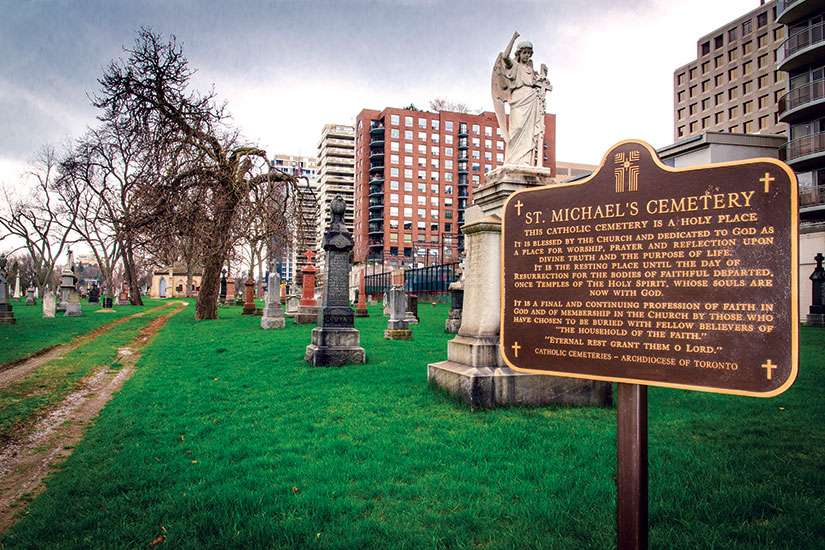At the time the diocese was founded in 1842, Toronto-area Catholics were buried in simple parish cemeteries. But then came the 1847 potato famine which sparked a mass migration of Irish to North America. Waves of destitute immigrants sailed to Toronto on so-called “coffin ships” which carried the deadly typhus disease.
The new arrivals were quarantined in fever sheds in the young city’s west end. There, in the summer of 1847, more than 800 Irish immigrants died. With Toronto’s few Catholic parish cemeteries quickly filling up, Bishop Armand de Charbonnel — who succeeded Michael Power after Toronto’s founding bishop died after contracting typhus while ministering in the fever sheds — purchased six acres of land north of the city and in 1855 he consecrated St. Michael’s Cemetery.
For the next half century it was the primary burial ground for Toronto Catholics and more than 29,000 people were buried there. Now closed, its grounds near the intersection of Yonge and St. Clair are surrounded by commercial and residential properties, but the grave sites are still accessible. But more than Catholic Toronto’s first large burial site, its opening marked the beginning of the non-profit organization Catholic Cemeteries and Funeral Services, which today oversees seven regional and 11 parish cemeteries on behalf of the Archdiocese of Toronto.
“Catholic Cemeteries (is) an extension of our Church community,” wrote Cardinal Thomas Collins. “They are unique and sacred testament to our beliefs in the resurrection of the body and our profound importance in the life of the archdiocese.”
The evolution of Catholic Cemeteries has been driven by a duty to meet the demands of the archdiocese’s expanding Catholic community.
“Our mission is to offer compassionate care for our families before, during and after the death and burial of a loved one,” said Amy Profenna, a spokesperson for Catholic Cemeteries.
Twelve years after St. Michael’s Cemetery was opened, St. Mary’s Cemetery in Barrie was consecrated in 1867. It continues to serve Catholics in the northern part of the archdiocese 150 years later.
As Toronto’s Catholic community grew rapidly towards the end of the 19th century, it became apparent that a second cemetery was needed to complement St. Michael’s. In stepped two prominent Catholic laymen — Frank Smith, owner of Toronto’s first transit system, and beer baron Eugene O’Keefe. They put up $5,000 to purchased a plot of land just four kilometres from St. Michael’s that was consecrated in 1898 as Mount Hope Catholic Cemetery.
With a burial capacity of about 70,000, Mount Hope became Toronto’s primary Catholic burial ground until the mid-20th century.
A period of “unprecedented growth” in the Greater Toronto Area following World War II led to the 1954 opening of Holy Cross Cemetery in Thornhill. A decade later, Resurrection Cemetery was opened in Whitby, followed in 1968 by Assumption Cemetery in Mississauga, Queen of Heaven in 1985 in Woodbridge and Christ the King Cemetery on the border of Markham and Scarborough in 2004. That same year, Catholic Cremation Services was also added to the Catholic Cemeteries portfolio.
Following changes in provincial legislation to allow funeral homes on cemetery property, in 2014 Catholic Cemeteries added Holy Cross Funeral Home to its 145-acre grounds at Holy Cross Cemetery.
Catholic Cemeteries also offers a number of bereavement and grief services, as well as holding annual Masses and prayer services for the faithfully departed at its sites. Profenna says these services serve as reminders “that we believe that life is changed, not ended,” at death. They also demonstrate “the great respect the Church has for the deceased.”


